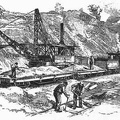Tunnels are neither so long nor so frequent upon American railways as upon those of Europe. The longest are from two to two and a half miles long, except one, the Hoosac, about four miles. Sometimes they are unavoidable. The ridge called Bergen Hill, west of Hoboken, N. J., is a case in point. This is pierced by the tunnels of the West Shore, of the Delaware, Lackawanna, and Western, and of the Erie, the last two of which, are placed at different levels to enable one road to pass over the other.
It is by our system of using sharp curves that we avoid tunnels. It may be said, in general terms, that American engineers have shown more skill in avoiding the necessity of tunnels than could possibly be shown in constructing them. When we are obliged to use tunnels, or to make deep cuttings in rocks, our labors are greatly assisted by the use of power-drills worked by compressed air and by the use of high explosives, such as dynamite, giant powder, rend-rock, etc. Rocks can now be removed in less than half the time formerly required, when ordinary blasting-powder was used in hand-drilled holes.
- Author
- The American Railway
Its Construction, Development, Management, and Appliances
Thomas Curtis Clarke
Theodore Voorhees
John Bogart
and others
Available from gutenberg.org - Posted on
- Friday 22 October 2021
- Dimensions
- 900*512
- Tags
- Occupations, Railroad
- Albums
- Visits
- 954
- Downloads
- 30
 Download Photo
Download Photo





